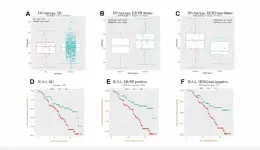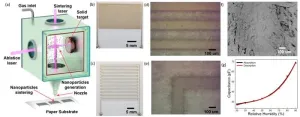(Press-News.org)
A large-language model (LLM) built to meet the needs of the Deaf community, translating between signed and spoken language, is the aim of a new project led by the University of Surrey.
SignGPT: Building Generative Predictive Transformers for Sign Language has been awarded £8.45m from the UK Engineering & Physical Sciences Research Council. The five-year project will build tools to allow spoken language to be automatically translated into photo-realistic sign language and video of sign language to be translated into spoken language – a complex translation problem that is yet to be solved.
Surrey will work alongside the University of Oxford, the Deafness Cognition, the Language Research Centre at University College London, key Deaf stakeholders, and the Deaf community.
Professor Richard Bowden, Principal Investigator of the project from the University of Surrey's Institute for People-Centred AI, said:
"Large language models such as those behind ChatGPT and Gemini are transforming many aspects of our personal and working lives – and that transformation is happening at a blistering pace. Our project, SignGPT, is not about replacing humans, but it is about ensuring the Deaf community is not left behind in this revolution.
"By creating technology that serves the community, we're enabling equal access to information, working towards seamless communication between the Deaf and hearing world, and demonstrating that AI can be a tool for inclusivity and empowerment. SignGPT isn't just about accessibility for Deaf people – it's about setting a standard for how innovation can address inequities, strengthen human connection, and build a more inclusive society. In a world shaped by rapid technological change, projects like this show that AI's potential is greatest when it uplifts everyone."
Globally, there are around 70 million Deaf or hard-of-hearing individuals, many of whom use sign language as their primary form of communication. For many, written/spoken languages serve as a second or third language and proficiency in these languages can vary. There is no universal sign language: sign languages are natural human languages created over centuries by Deaf communities and are not derived from spoken languages. Their underlying rules and structures remain a rich area of linguistic study. Each sign language has its own unique grammar and lexicon, relying on both manual gestures (hands) and non-manual expressions (body and face), along with spatial elements, to convey meaning.
Professor Bencie Woll, sign linguist, co-investigator of the project, and founder of the Deafness Cognition and Language Research Centre at UCL, said:
“This project is a unique collaboration between vision scientists and sign linguists with Deaf and hearing researchers working together towards our common goals.”
Mark Wheatley, CEO of the Royal Association for Deaf People (RAD), said:
“I am pleased that this important grant will empower the Deaf community to have further equal access by harnessing AI and large language models. We will ensure that the University of Surrey, Oxford University, and the Deafness Cognition and Language Research Centre at UCL, alongside Deaf-led stakeholders such as RAD, take a people-centred approach to ensuring ethical responsibility and the accuracy of translations so that we, the Deaf community, can use them for everyday purposes.”
Professor Kearsy Cormier, one of the Co-Investigators on the project from University College London, said:
“So much work in sign language technology is undertaken by researchers with no understanding of how sign languages work, nor any lived experience of deafness themselves. This project will allow real co-creation/co-development of this technology with Deaf and hearing researchers in linguistics and deaf studies working alongside computer vision specialists – with each group learning from each other – and, importantly, building capacity amongst Deaf researchers so they may lead this field in the future.”
SignGPT's research team will produce the largest sign language dataset in the world and use it to build a sign language LLM that can provide the breadth of application to the Deaf community that current LLMs provide for written/spoken languages. In doing so, the project will also generate tools for data annotation that will be released for use by the wider community. The project already has Deaf members within both the research team and wider partners, but it is hoping to recruit more staff for whom British Sign Language is their primary language.
The challenge of automatically translating between sign languages and spoken languages is highly complex and remains unsolved. SignGPT will produce open-source toolkits for linguistic use, web-based demonstrations for accessible knowledge exchange and run outreach programmes alongside collaborative workshops.
###
Notes to editors
The SignGPT team consists of: University of Surrey (Professor Richard Bowden, lead), Oxford University (Professor Andrew Zisserman), and the Deafness Cognition and Language Research Centre at University College London (Professor Kearsy Cormier and Professor Bencie Woll).
About the Surrey Institute for People-Centred AI (PAI)
Taking a different approach to much AI activity in the UK, the Surrey Institute for People-Centred AI puts the needs of individuals and society at the very heart of everything it does: we believe that the starting point for AI should be people rather than technology.
This people-centred approach drives our research and enables us to design AI technologies and systems that are ethical, responsible, and inclusive. The pan-University Institute brings together Surrey'sSurrey's core AI-related expertise in vision, speech and signal processing, computer science, and mathematics, with its domain expertise across engineering and physical sciences, human and animal health, law and regulation, business, finance and the arts and social sciences. With this distinctive approach, PAI builds on Surrey's track record of collaboration with industry, the public sector, government and other relevant institutions to develop solutions to shared challenges.
To find more details, visit surrey.ac.uk/ai or follow @peoplecentredai
END
SignGPT – Project awarded £8.45m to build a sign language AI model for the Deaf community
2025-01-21
ELSE PRESS RELEASES FROM THIS DATE:
Garden ponds: Hidden gems of urban biodiversity conservation
2025-01-21
Urbanisation is rapidly transforming landscapes worldwide, becoming a key driver of global biodiversity loss. It often impacts biodiversity negatively by creating selective environments that limit species diversity in urban compared to natural habitats. Amidst this challenge, understanding and enhancing urban blue-green infrastructure is critical. Garden ponds are small yet significant water features that are increasingly common in urban areas. They offer numerous ecosystem services, like aesthetic purposes, microclimate regulation, and habitats for ornamental species. However, their role in supporting ...
Epigenetic aging and DNA-methylation as tumor markers for breast cancer
2025-01-21
“Our study contributes to the development of a DNAm biomarker that integrates conventional BC risk factors to better reflect the risk for BC subtypes, promoting epigenetically targeted preventive interventions tailored to aged individuals with high risk.”
BUFFALO, NY- January 21, 2025 – A new research paper was published in Aging (listed by MEDLINE/PubMed as "Aging (Albany NY)" and "Aging-US" by Web of Science) on December 5, 2024, Volume 16, ...
Salt deposit ring inside your pasta pan?
2025-01-21
WASHINGTON, Jan. 21, 2025 – If you’ve ever tossed a generous pinch of salt into your pasta pan’s water for flavor or as an attempt to make it boil faster, you’ve likely ended up with a whitish ring of deposits inside the pan.
A group of scientists from the University of Twente in the Netherlands and the French National Institute for Agriculture, Food, and Environment (INRAE), inspired by this observation during an evening of board games and pasta dinner, wondered what it ...
First fast radio burst traced to old, dead, elliptical galaxy
2025-01-21
For the first time, astronomers have traced a fast radio burst (FRB) to the outskirts of an ancient, dead, elliptical galaxy — an unprecedented home for a phenomenon previously associated with much younger galaxies.
Detailed in two complementary studies led by Northwestern University and McGill University, the discovery shatters assumptions that FRBs solely emanate from regions of active star formation. The new observational evidence, instead, hints that the origins of these mysterious cosmic events might be more diverse than ...
We can make fertilizer more efficiently under the surface of the Earth
2025-01-21
Instead of relying on energy-hungry reactors to generate high temperatures and pressure, researchers are looking underground at Earth’s natural heat and forces to cook up ammonia for fertilizer. In a proof-of-concept study, published January 21 in the Cell Press journal Joule, researchers generated ammonia by mixing nitrogen-laced water with iron-rich rocks—without any energy input or CO2 emission. This new recipe may lead to a more sustainable alternative to current methods, theoretically churning out enough ammonia for 2.42 million years.
The idea stems from an unusual geological phenomenon observed in the 1980s in Mali, West Africa. Locals discovered a well ...
What's behind preterm birth? Scientists just found a big clue
2025-01-21
What's Behind Preterm Birth? Scientists Just Found a Big Clue
UCSF researchers discovered a molecular timer that gets activated in the first days of pregnancy and influences when mice give birth.
A typical human pregnancy lasts 40 weeks, but most parents know this number is only a rough estimate.
Babies are born on a seemingly unpredictable timeline, with a normal pregnancy ranging from 38 to 42 weeks. And 10 percent of all births are preterm, meaning they occur before 37 weeks of gestation, which puts babies at risk of a host of complications.
Now, UC San Francisco researchers have discovered a molecular timer in mice that plays a role in controlling ...
The importance of eco-friendly sensors in global food supply
2025-01-21
WASHINGTON, Jan. 21, 2025 – Greenhouses and open farms that welcome visitors to purchase locally grown produce and meat have become increasingly important to food productivity. Not only are farmers looking for ways to monitor conditions to help improve greenhouse crop growth and yield, but keeping harvested food fresh in storage conditions is also a major concern. Smart sensor technology, monitoring and controlling temperature and humidity, plays an essential role in producing enough food to meet the ever-increasing demand ...
Brain immune cells may also be from Mars and Venus
2025-01-21
A collision happens. Someone is hurt, a head injury, a concussion. Just as the first responders arrive to help the person, inside the brain, another “crew” of responders is busy clearing debris and repairing injured tissue.
This crew is called the microglia - the immune cells of the central nervous system. Microglia are imperative to maintaining neuronal function by clearing toxins in the brain and central nervous system. But if they are overactive, they can damage neurons instead and, in some cases, have been found to promote the progression of neurodegenerative diseases like Alzheimer’s and Parkinson’s.
During ...
Effect of pediatric obesity treatment on long-term health
2025-01-21
About The Study: This cohort study demonstrated that good response to pediatric obesity treatment was associated with reduced long-term morbidity, such as type 2 diabetes, dyslipidemia, and hypertension. Additionally, a link between pediatric obesity treatment effectiveness and lower incidences of mortality in young adulthood was observed; however, effective pediatric obesity treatment was not associated with adult depression or anxiety, highlighting their distinct nature despite frequent coexistence.
Corresponding Author: To contact the corresponding author, Emilia Hagman, PhD, email emilia.hagman@ki.se
To access the embargoed study: Visit our ...
Factors associated with semaglutide initiation among adults with obesity
2025-01-21
About The Study: This cohort study found that key sociodemographic, health care, and clinical factors are associated with receipt of semaglutide, a novel glucagon-like peptide-1 (GLP-1) receptor agonist medication, in those without diabetes. These findings suggest that insurance plan type and structure may be a crucial intervention point for improving equity in obesity treatment access.
Corresponding Author: To contact the corresponding author, Andrew C. Stokes, PhD, email acstokes@bu.edu.
To access the embargoed study: Visit our For The Media website at this link https://media.jamanetwork.com/
(doi:10.1001/jamanetworkopen.2024.55222)
Editor’s ...






